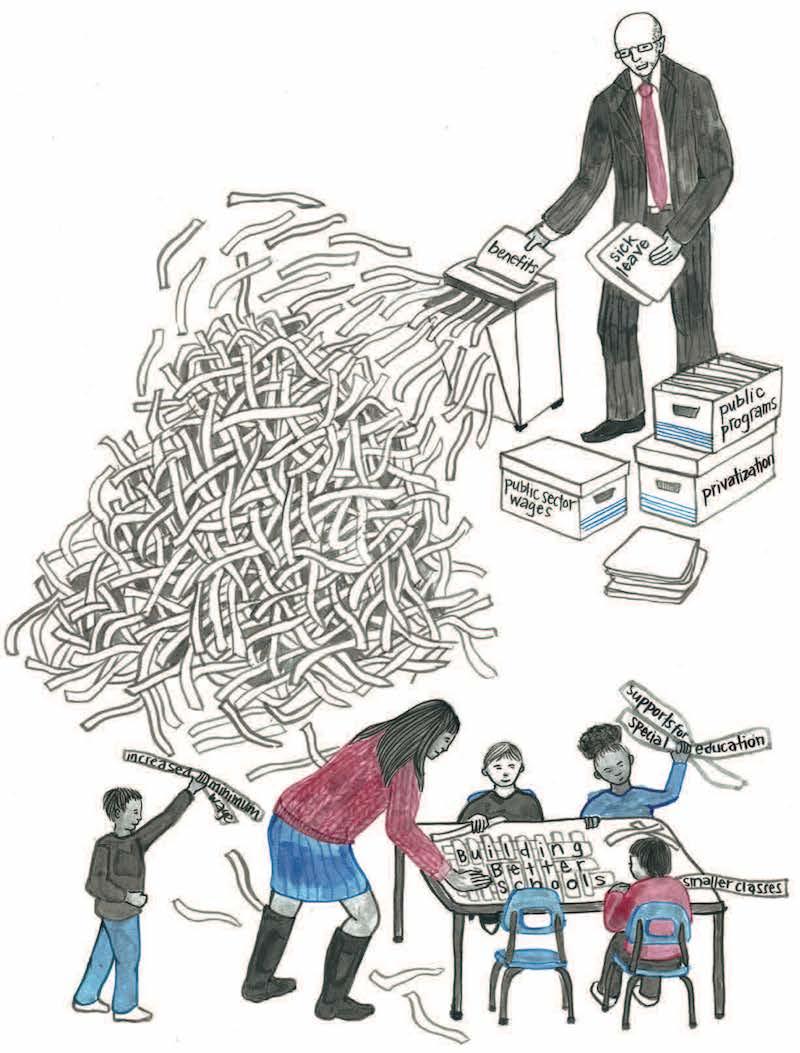
Ontario's Austerity Agenda
Half a decade ago, the Ontario Liberal government responded to a downturn in the economy by introducing austerity measures designed to address a growing fiscal deficit. Today, the government is finding that the chickens have come home to roost; Ontarians are fighting back against the fallout of its austerity agenda. ETFO and its members have suffered the impact of that agenda and are engaged, along with others in the labour movement, in calling for a new vision for the province.
The global financial crisis of 2008-2009, sparked by the crash in the Wall Street markets in the United States, led to a significant loss of manufacturing jobs in Ontario, jobs that were, for the most part, well-paid union jobs that included benefits. Both the federal and Ontario governments initially introduced stimulus measures to respond to the recession that followed the financial crisis. However, both levels of government quickly abandoned that approach in favour of austerity measures – program cuts, public sector wage freezes and cuts to public sector benefits.
Attack on Public Sector Workers
Ontario’s austerity agenda began in 2011 with former Premier Dalton McGuinty appointing former TD bank economist Don Drummond to lead a study on how to address the growing fiscal deficit, a deficit caused by declining tax revenue due to economic decline as well as reduced federal transfers from the Harper government bent on reducing taxes and the role of government. From the get-go, the public sector was set up as the commission’s target; the commission was tasked with focusing only on the expenditure side of the deficit equation, not conducting a holistic analysis that included looking at how the province could generate additional revenue to balance the budget.
The decline in private sector manufacturing jobs meant that it was primarily public sector workers who enjoyed relative job security, decent salaries and benefits. The government calculated there would be public support for targeting these workers for cuts. These unionized workers’ salaries and benefits were no longer seen as a benchmark for the broader workforce to aspire to but rather something taxpayers could no longer afford to support.
Released in early 2012, the Drummond report’s recommendations for public sector cuts were extensive. For elementary education, the report recommended cancelling full-day kindergarten or, if maintaining the program, delaying its implementation and abandoning the staffing model that included early childhood educators. It also recommended increasing class size for all elementary grades, meaning 5,900 fewer teaching positions, and an elimination of 70 per cent of support staff positions, for annual savings of $600 million by 2017-18.
In embracing the Drummond recommendations, the McGuinty government didn’t adopt the most extreme proposals for elementary education. But the report gave the government political cover for implementing public sector wage freezes and attacking benefits like sick leave and retirement gratuities. It contributed to the government’s calculation that it could get away with Bill 115, which abrogated education sector workers’ bargaining rights and imposed terms of their collective agreements.
Program Spending Falls Short
Following the Drummond report in 2012, Ontario budgets have been austerity budgets. Their biggest impact has been on shortchanging public programs and services that Ontarians rely on. In the 2013 budget, the Ontario government stated it was on track to implement 60 per cent of the Drummond report’s spending cuts and touted it had “the lowest program spending per capita among Canadian provinces.” Ontario’s 2016 budget reports that the province continues to deliver on the latter claim. It has done so, in part, by keeping program spending increases below the rate of inflation. The Ministry of Finance’s Economic Outlook and Fiscal Review 2015 reported that, over the last four years, Ontario has held program spending increases to 1.4 per cent, less than inflation. The Financial Accountability Office of Ontario reports that education spending is projected to grow by an average of 1.3 per cent annually from 2014-15 to 2017-18, during which inflation is projected to average 2.0 per cent annually.
The shortfall in program spending means the government is failing to address education issues such as increasing supports for students with special needs and reducing class size in Kindergarten and grades four to eight. It also means the government’s poverty reduction strategy is offside and Ontario’s most vulnerable citizens – social assistance recipients, Ontarians with disabilities, Indigenous peoples, immigrants and refugees – are among the most negatively affected by the austerity agenda.
Harris-Era Tax Cuts Continue
A significant aspect of Ontario austerity has been the failure to address the revenue side of the deficit conundrum – essentially its taxation policies. Since forming government in 2003, the Liberals have not changed essential tax policies introduced during the previous Progressive Conservative government, including cuts to personal income taxes that have disproportionately benefited high-income Ontarians and cuts to corporate and small-business taxes, which have failed to deliver the increased investment and job creation they were designed to do. Ontario Ministry of Finance documents continue to boast that Ontario’s corporate tax rates are lower than those south of the border. Economists associated with the Canadian Centre for Policy Alternatives estimate that the impact of cuts to personal and corporate income taxes initiated during the Harris era and continued today amounts to a loss to the provincial treasury of $17 billion annually. Just think what a small portion of that could do to support ETFO’s Building Better Schools plan and address other public sector programs.
Austerity Contributes to Precarious Work
Ontario’s below-inflation program spending is a fiscal drag on the economy. Less spending on programs, reduction in the number of public sector jobs and diminished real incomes for public sector workers depress consumer spending and limit tax revenue. The government’s over-reliance on corporate and small-business tax cuts to stimulate job creation is also undermining Ontario’s economic recovery. This results in too many Ontarians struggling with part-time work, temporary or minimum-wage work. Women are particularly affected since they comprise about 58 per cent of minimum-wage workers.
In the education sector, occasional teachers know all too well the vagaries of precarious work. For the last decade, occasional teachers have had to wait for an average of seven years before securing a full-time contract with a school board. During that time, many young teachers have had to deal with unpredictable salaries and no benefits and often with putting their lives on hold. Were the Ontario government to address the need to reduce class size in elementary classrooms, many of these teachers would find contract positions and leave the world of precarious work behind them.
Austerity Leads Government to Privatization
Failure to address the issue of tax reform or other “revenue tools” has led Ontario to rely more on privatization to fund infrastructure projects. The Ontario government relies heavily on public-private partnerships (P3s) to find the upfront funds to build transit lines, hospitals and court houses. The projects remain in public hands, but the cost to the taxpayer is considerable. The 2014 Ontario’s Auditor General’s report indicated that a review of 74 P3 projects showed they cost taxpayers $800 billion more than if the projects had been built by the public sector. The report found that there was no empirical data to support the government rationale regarding the alleged savings from the P3 approach, including the claim that public sector-managed projects incurred costly overruns because they aren’t completed on time.
Ontario has also resorted to a partial privatization of the public utility Hydro One as a means to find funds to assist with meeting its promise to balance the deficit by 2017-18 and fund badly needed infrastructure projects. This policy, announced after the 2014 provincial election when Kathleen Wynne had assumed the helm of the Ontario Liberal Party, came as a surprise to many who find it at odds with the premier’s narrative of bringing forward a more progressive agenda. Economists estimate that once the entire 60 per cent of Hydro One is divested, the Ontario treasury will lose close to $340 million annually. Like the P3 projects, privatization of Hydro One seems motivated by an immediate need for funds but belies the longer-term cost implications.
Is Ontario Turning The Page On Austerity?
There are signs that the Ontario government is stepping back from its austerity agenda as Ontarians indicate they have had enough with the impact of program cuts. In the spring, shortly after announcing the 2016 budget, the government quickly backtracked from its plan to raise the income threshold for seniors to qualify for drug coverage. Shortly after, parents of children with autism rallied against the announcement that children with autism aged five or older would no longer have access to Intensive Behaviour Intervention (IBI) therapy. Although the government attempted to dig in its heels and defend the policy as a means to eliminate the long waiting list for IBI services, it finally succumbed to the pressure and announced a change in policy along with an additional $200 million in funds.
Recent Ministry of Education announcements also indicate the government’s attempt to reposition itself. In July, in response to an effective grassroots campaign about the declining physical state of many Ontario schools, the ministry announced an additional $1.1 billion in renewal funding for the 2015-16 and 2016-17 school years. Similar to the autism issue, the government announced it was stepping back, at least temporarily, from the possible closure of some of the provincial and demonstration schools that serve students with severe learning disabilities. In the September Speech from the Throne, the government announced the commitment to fund an additional 100,000 childcare spaces, a policy designed to recapture the moniker of an “activist” government.
Perhaps the most telling policy announcement is the premier’s comment that the government will not be imposing a “net zero” limit on the next round of public sector bargaining. It is probably fair to say the government does not wish to revisit the labour unrest prompted by Bill 115 and is looking ahead to the next provincial election scheduled for June 2018.
What Are We Doing To Promote An Alternative Vision?
Through its communications and activism, ETFO is promoting an alternative vision to austerity. Our Building Better Schools plan promotes important improvements to elementary education that address both student learning conditions as well as our members’ working conditions. Implementing the plan would require changes to the education funding formula and significant new investment. To create the capacity to reform education funding as well as address increased investments in other social programs, ETFO is calling for tax reform that increases revenue while addressing the issue of tax fairness.
Beyond tax reform, ETFO has joined others in the labour movement to advocate for improvements to employment standards, an increased minimum wage and accessible, affordable childcare. These reforms are essential to closing the growing wealth gap and creating a society where all Ontarians have an opportunity to succeed. These reforms and investment in public services are what Ontario needs to turn the page on the failed policy of austerity.
Vivian McCaffrey is an executive staff member at ETFO

